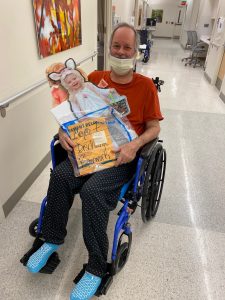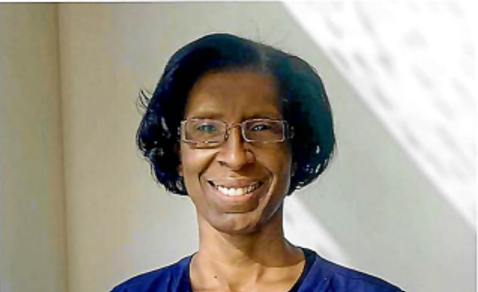Johns Hopkins UniversityEst. 1876
America’s First Research University
For Robert Kalbach, the last few months of his father’s life were focused on silver linings.
Kalbach brought his father, Bob, from Pennsylvania to the Johns Hopkins Hospital in early 2022 in search of answers. Immediately, Kalbach was impressed with the Hopkins team in the Department of Neurology — they spent time to understand what Bob had been experiencing medically for the previous three weeks.

Bob was admitted to Hopkins’ Brain Rescue Unit (BRU), and cancer was discovered during the course of his care.
“Hopkins did a good job, although what they found was bad,” Kalbach says. “It’s a blessing and a curse, but it’s definitely a silver lining because you can say the things that you want to say and cherish the last moments.”
As Bob received comfort care at Hopkins, Kalbach and his family made sure someone was with him every day, even as COVID restrictions limited visitation. But Kalbach says there was still a degree of loneliness, and Bob missed his then-2-year-old granddaughter. Kalbach and his wife decided to print a life-size photo of their daughter, blonde hair peeking out from under a bunny costume.
“It just got the focus on something positive, his granddaughter,” Kalbach says. “Seeing that smiling face, especially when you’re receiving bad news, helps keep spirits up.”
The nurses and other care providers took notice of the photo resting on Bob’s windowsill. The life-size photo of the little girl prompted comments and conversations, as well as smiles.
As Kalbach and his father spent time together, watching the reactions to his daughter’s photo, they hatched a plan — offer customized photos to other patients to spark joy and increase resilience.
“That was another silver lining,” Kalbach says. “It gave us a mission. The idea of helping others when you’re undergoing palliative care is a very powerful thing.”
Kalbach engaged the team at Hopkins and worked to develop the new Photos for Patients program. With a background in construction and engineering, Kalbach’s aptitude for problem-solving kicked in. He worked with a local professional printer to create samples printed on waterproof material so the photos could be easily sanitized. He also left samples around the BRU to generate interest, and the father-son duo would pitch the program to anyone who visited Bob’s room.

The unit’s nurses loved the idea. Tenise Shakes, Johns Hopkins Hospital nurse manager of Zayed 12 West and the BRU, and her team solidified the process for printing and delivery and maintaining patient confidentiality. They also partnered with IT to make the process secure. A QR code in every patient’s room allows the family to use their smartphone camera to answer questions and upload images.
“When the program was proposed to us, we were already motivated. It’s our goal to provide a great experience for our patients,” Shakes explains. “We were inspired by creating another great opportunity to support our patients in their recovery.”
Thanks to Kalbach’s giving and his work with the Hopkins team to establish the program, about 120 patients have taken advantage of Photos for Patients. Patients can upload whatever images they find most inspiring — family, pets, vacation photos. Shakes and her team print the 11×14-inch photo on canvas to be displayed in the patient’s room on an easel. They’ve also created workarounds to ensure that even blurry photos turn out beautifully.
Medical Director of the Brian Rescue Unit Mona Bahouth, MD, PhD, who treated Bob, has worked with the patients and their families to analyze the program’s impact on recovery. A hospital stay is often overwhelming, Bahouth says, and in the case of stroke, isolating. A stroke happens in an instant and changes a person’s ability to move, speak, interact, or care for oneself.
“All of our endeavors in the Brain Rescue Unit are to advance the care to include the most cutting-edge interventions while assuring that the human side of medicine is maintained. The Photos for Patients program is one of those initiatives,” she explains.

Photos for Patients has had a broad impact on the BRU. Bahouth says patients report feeling much calmer with photos of people or pets. The program also gives family members the opportunity to help decrease the stress of a loved one being in the hospital and allow the care team to interact with the patient on a more personal level.
“Taken together, we feel that this type of program decreases a patient’s sense of isolation and loneliness, and reduces hospital-acquired delirium,” Bahouth says. “So much joy has come from this gracious donation and program.”
Photos for Patients has also uplifted the staff.
“We were so inspired by the positivity and productivity of the Kalbach family and grateful that they showed appreciation to our team by helping to honor other patient and family needs,” Bahouth says.
As a cost-effective way to help inspire patients, Kalbach’s family has established Photos for Patients programs at other medical centers, as well. Though Bob passed away in March 2022, Kalbach made a commitment to his father to continue the project they conceived together. He says Bob would be proud of how Photos for Patients has grown. It’s now a part of his legacy.
“Hopkins was the first to do it,” he says. “When other medical systems hear that Hopkins is doing something, everybody listens, and that’s a really cool thing.”
For Shakes, Photos for Patients is encouragement to think outside the box.
“It was absolutely inspiring to us that the Kalbachs wanted to donate and create something that would impact other patients,” she says. “For people who give donations to Hopkins, in whatever capacity, it’s an opportunity to not just look out for your own interests but also for the interests of others.”
Topics: Friends of Johns Hopkins Medicine, Neurology, Promote and Protect Health